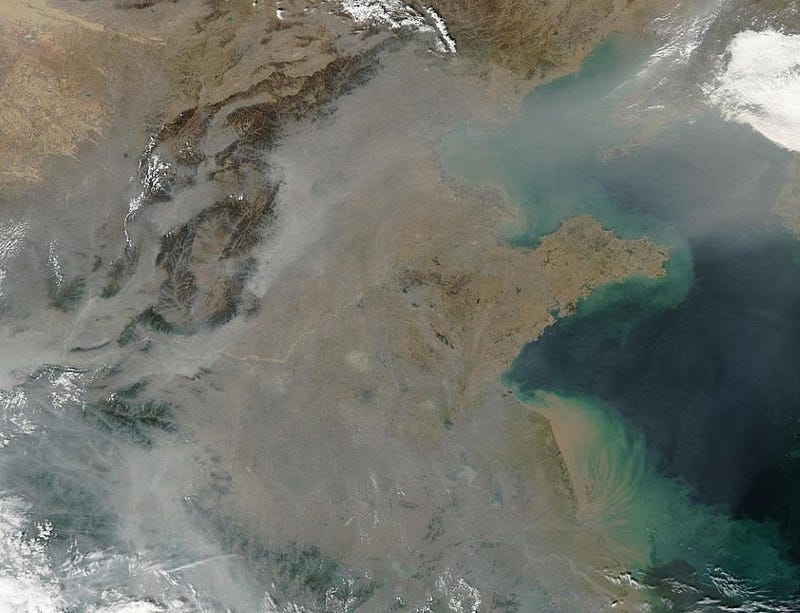Pluto’s Mysteriously Cool Atmosphere Might Hold The Key To Fighting Global Warming

If atmospheric hazes can cool the distant ice dwarf by an extra 30 degrees Celsius, maybe we can geoengineer a solution to our warming problem?
When NASA’s New Horizons flew by Pluto in 2015, it didn’t just give us our greatest views of our Solar System’s largest world beyond Neptune, but discovered a scientific surprise: Pluto was much cooler than we had expected. While its temperature instruments recorded a mean temperature of 70 K (-333 °F), Pluto’s distance from the Sun, reflectivity, and atmospheric contents indicated that it should have been about 30 °C (54 °F) warmer than that. While many ideas have abounded as to the cause of this discrepancy, a team of researchersbelieve they’ve solved the mystery, and the culprit is Pluto’s atmospheric hazes. If this turns out to be correct, the cooling effect on Pluto might have applications here on Earth, with the potential to someday become a secret weapon in the fight against global warming.

What determines the average temperature of a planet? It’s only a handful of things:
- how much radiation it receives from the Sun,
- its absorption/reflectivity properties,
- and the planet’s atmosphere.
Under normal circumstances, that third factor is usually determined by the gas contents of the atmosphere. So long as the properties of a gas are known across a variety of wavelengths, we can compute what the temperature ought to be. New Horizons did a fantastic job measuring the contents and properties of Pluto’s atmosphere, allowing us to come up with a solid model that we thought, for sure, ought to work.

Yet NASA’s New Horizons mission also measured the temperature of Pluto, and found that it was cooler than we had expected. For some reason, Pluto was either not receiving as much heat as we expected, or was more efficient at radiating it away than we had anticipated. According to a new study published in Nature today, “Haze heats Pluto’s atmosphere yet explains its cold temperature” by X. Zhang, D. Strobel & H. Imanaka, the reason our models fared so poorly is because Pluto’s atmosphere isn’t just made up of gases, but hazes as well. And it’s the hazes, particles in the solid rather than the gaseous phase, that are responsible for Pluto’s energy budget.

Pluto’s atmosphere is mostly composed of light gases, such as molecular nitrogen and methane. Although the distance from the Sun keeps Pluto extremely cold, there’s still high-energy, ultraviolet light reaching it. When that short-wavelength light strikes these molecules, the nitrogen and methane become ionized, as electrons get kicked off. That enables these molecules to react, forming much more complex hydrocarbons that are some ~100 times larger than the nitrogen and methane molecules they were formed from. Since these new particles are larger and more massive than the rest of the atmosphere, they begin to sink, sticking together as they descend. Eventually, they’ll settle down onto the surface as a form of Plutonian precipitation.

According to Xi Zhang, lead author on the new study, these hydrocarbons are responsible for the red-and-brown deposits we can see in New Horizons’ color imagery of Pluto’s surface.
We believe these hydrocarbon particles are related to the reddish and brownish stuff seen in images of Pluto’s surface… Pluto is the first planetary body we know of where the atmospheric energy budget is dominated by solid-phase haze particles instead of by gases.
From a temperature perspective, this makes a huge difference. While a haze-free Pluto ought to be at a temperature of 100 K, the Pluto we have is extraordinarily cooler at a mere 70 K. This temperature difference, of 30 °C (54 °F), is more than a factor of 10 greater than the impact human beings have had on Earth due to the industrial emission of greenhouse gases.

Earth has demonstrated a similar capability: through the phenomenon of global dimming. Unlike the complex hydrocarbon hazes of Pluto, Earth’s hazes are caused by a combination of natural factors (such as volcanic eruptions and forest fires) and human-caused ones (such as sulfate aerosols and small particulate pollutants). Because of all the natural water on Earth, these particulates serve as the seeds for water droplets in clouds, with smaller particles producing smaller droplets, which are more reflective.

Global dimming could someday provide a geoengineering solution to counteract the effects of global warming, if our environmentally-minded efforts to curb our emissions fail. The discovery of the haze-temperature connection on Pluto demonstrates, for the first time, that there are actual cases out there where this type of effect can serve to reduce the worldwide temperature by far more than humanity’s emissions have increased it. On the surface, it provides a new hope for geoengineering scenarios to mitigate global warming. However, there are side effects associated with having pollutants and potentially toxic particulates in our clouds, and therefore our rainwater. We must ensure, before embarking down such a path, that the cure isn’t worse than the disease.

What began as a surprising anomaly — that Pluto’s temperature was far cooler than anyone had expected — led to an incredible find: the haze-temperature connection. If these hazes can cool Pluto down by so much, perhaps it gives us hope that we can find a safe, stable way to engineer the same effect here on Earth. While many worry that we may have passed the climate tipping point, humanity is not a sit-back-and-do-nothing type of species. We may not be in control of our planet as much as we like, but we’re certainly at the controls. What we’ve learned about Pluto may just be the key to our greatest weapon in the fight against global warming.
Ethan Siegel is the author of Beyond the Galaxy and Treknology. You can pre-order his third book, currently in development: the Encyclopaedia Cosmologica.





